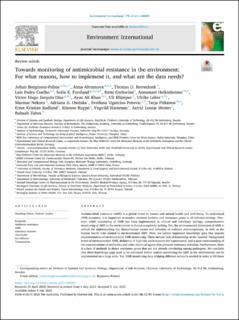| dc.contributor.author | Bengtsson-Palme, Johan | |
| dc.contributor.author | Abramova, Anna | |
| dc.contributor.author | Berendonk, Thomas U. | |
| dc.contributor.author | Coelho, Luis Pedro | |
| dc.contributor.author | Forslund, Sofia K. | |
| dc.contributor.author | Gschwind, Remi | |
| dc.contributor.author | Heikinheimo, Annamari | |
| dc.contributor.author | Jarquin-Diaz, Victor Hugo | |
| dc.contributor.author | Khan, Ayaz Ali | |
| dc.contributor.author | Klümper, Uli | |
| dc.contributor.author | Löber, Ulrike | |
| dc.contributor.author | Nekoro, Marmar | |
| dc.contributor.author | Osinska, Adriana Dorota | |
| dc.contributor.author | Ugarcina Perovic, Svetlana | |
| dc.contributor.author | Pitkänen, Tarja | |
| dc.contributor.author | Rødland, Ernst Kristian | |
| dc.contributor.author | Ruppe, Etienne | |
| dc.contributor.author | Wasteson, Yngvild | |
| dc.contributor.author | Wester, Astrid Louise | |
| dc.contributor.author | Zahra, Rabaab | |
| dc.date.accessioned | 2023-09-14T07:27:07Z | |
| dc.date.available | 2023-09-14T07:27:07Z | |
| dc.date.created | 2023-08-16T09:09:02Z | |
| dc.date.issued | 2023 | |
| dc.identifier.citation | Environment International. 2023, 178 . | |
| dc.identifier.issn | 0160-4120 | |
| dc.identifier.uri | https://hdl.handle.net/11250/3089332 | |
| dc.description.abstract | Antimicrobial resistance (AMR) is a global threat to human and animal health and well-being. To understand AMR dynamics, it is important to monitor resistant bacteria and resistance genes in all relevant settings. However, while monitoring of AMR has been implemented in clinical and veterinary settings, comprehensive monitoring of AMR in the environment is almost completely lacking. Yet, the environmental dimension of AMR is critical for understanding the dissemination routes and selection of resistant microorganisms, as well as the human health risks related to environmental AMR. Here, we outline important knowledge gaps that impede implementation of environmental AMR monitoring. These include lack of knowledge of the ‘normal’ background levels of environmental AMR, definition of high-risk environments for transmission, and a poor understanding of the concentrations of antibiotics and other chemical agents that promote resistance selection. Furthermore, there is a lack of methods to detect resistance genes that are not already circulating among pathogens. We conclude that these knowledge gaps need to be addressed before routine monitoring for AMR in the environment can be implemented on a large scale. Yet, AMR monitoring data bridging different sectors is needed in order to fill these knowledge gaps, which means that some level of national, regional and global AMR surveillance in the environment must happen even without all scientific questions answered. With the possibilities opened up by rapidly advancing technologies, it is time to fill these knowledge gaps. Doing so will allow for specific actions against environmental AMR development and spread to pathogens and thereby safeguard the health and wellbeing of humans and animals. | |
| dc.description.abstract | Towards monitoring of antimicrobial resistance in the environment: For what reasons, how to implement it, and what are the data needs? | |
| dc.language.iso | eng | |
| dc.subject | Antimikrobiell resistens | |
| dc.subject | Antimicrobial resistance | |
| dc.title | Towards monitoring of antimicrobial resistance in the environment: For what reasons, how to implement it, and what are the data needs? | |
| dc.title.alternative | Towards monitoring of antimicrobial resistance in the environment: For what reasons, how to implement it, and what are the data needs? | |
| dc.type | Peer reviewed | |
| dc.type | Journal article | |
| dc.description.version | publishedVersion | |
| dc.subject.nsi | VDP::Medisinsk mikrobiologi: 715 | |
| dc.subject.nsi | VDP::Medical microbiology: 715 | |
| dc.source.pagenumber | 14 | |
| dc.source.volume | 178 | |
| dc.source.journal | Environment International | |
| dc.identifier.doi | 10.1016/j.envint.2023.108089 | |
| dc.identifier.cristin | 2167239 | |
| dc.relation.project | Norges forskningsråd: 320349 | |
| cristin.ispublished | true | |
| cristin.fulltext | original | |
| cristin.qualitycode | 1 | |
